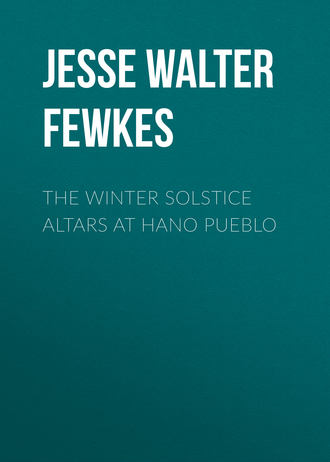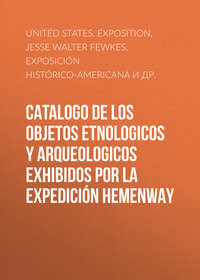 полная версия
полная версияПолная версия
The Winter Solstice Altars at Hano Pueblo
17
Among the Hopi the moon (Tewa p'o) is called müiyaûh; new moon, müiyakatci; first quarter, müiyachaunacapti; full moon, müiyanacapti. An eclipse of the moon is spoken of as müiyaûh moki, "dead moon." There was a total eclipse of the moon visible at Walpi near the end of December, 1898, when the full moon arose partially obscured. This, said Sikyatala, was bad for the Americans who dwell in the far east, but not for the Hopi. A "dead moon," when in the meridian of the Hopi pueblos, is considered kalolamai, "bad."
18
The Winter Solstice Ceremony at Walpi, op. cit.
19
The Asa people are also called the Tcakwaina clans. The ruins of their old village, near the western point of Awatobi mesa, are called Tcakwaina-ki. Its walls do not appear above the surface.
20
The particular ceremony of the Pakab peoples is the Momtcita, a single day's rite which occurs just after the Soyaluña, under direction of Pautiwa. Connected with this ceremony are the performances of the "stick swallowers" or Nocoto priests who were thought to be extinct at Walpi, but Eewa is chief of the Nocotana priests, and the society includes Wikyatiwa, Talahoya, Sikyaventima, and others. They still practice stick-swallowing. Pautiwa is chief of the Kalektaka, a warrior priesthood. He belongs to the Eagle clan of the Pakab phratry, which may be related to the Awata or Bow clan of the former pueblo of Awatobi.
21
Tcoshoniwa is generally called by a nickname, Tcino, "Bald-head," or "Curly-hair," a sobriquet to which he strongly objects. He is one of the oldest men of Sitcomovi, belongs to the Patki clan, and was formerly the kimoñwi or governor of Sitcomovi. Hani, of the Piba (Tobacco) clan, is political chief of Walpi; and Anote, also of the Piba clan, is chief of Hano. All the pueblos have kimoñwis or governors, and the office dates from early times; but these pueblo chiefs have no authority over pueblos other than their own.
22
The orientation of the Hano kivas is not far from that of the other East Mesa kivas, or about north 44º west.
23
The chief kiva had a small stove, an innovation which was greatly appreciated by the writer.
24
So named by the Hopi; the Tewa call him Tem[)e], At Hano almost everyone has a Hopi and a Tewa name.
25
Son of Kutcve and Kotcampa of the Kolon-towa, or Corn clan; commonly called "Esquash" by Americans.
26
The corn-husk packet of meal seems to be wanting in Zuñian, Keresan, and Tanoan prayer-sticks, but it is almost universally present in those of the Hopi. The Tanoan prayer-stick is called o'dope.
27
A cephalic horn is an essential organ of the Great Snake, and is always represented in pictography and on graven or other images of this being. Note the similarity of his Tewa name to the Spanish word abajo, "below."
28
This is the first time songs have been noted while an altar was being put in place.
29
This was a four-stranded string of cotton, as long as the outstretched arm, measured from over the heart to the tip of the longest finger. It is supposed to be a roadway of blessings, and the trail of meal is the pathway along which, in their belief, the benign influences of the altar pass from it to the kiva entrance and to the pueblo.
30
Pocine is a youth not far from seventeen years of age. His marriage ceremony was studied by the writer a week before the Tûñtai.
31
The triangle among the Hopi is almost as common a symbol of the rain-cloud as the semicircle. It is a very old symbol, and is frequently found with the same meaning in cliff-houses and in ancient pictography.
32
It was found in studying the four lightning symbols on this Tewa altar that sex is associated with cardinal points as in the Walpi Antelope altar. The lightning of the north is male, that of the west female, the south male, and the east female. The same holds with many objects in Hopi altars; thus the stone objects, tcamahia, of the Antelope altar follow this rule. In the same way plants and herbs have sex (not in the Linnean meaning), and are likewise associated with the cardinal points.
33
This sprinkling of corn seeds upon the meal picture of a Hopi altar is mentioned in an account of the Oraibi Flute ceremony. The evident purpose of this act is to vitalize the seeds by the accompanying rites about the altar.
34
Called omowûh-saka, "rain-cloud ladders."
35
Smithsonian Report, 1895, pl. lvii.
36
The American Anthropologist, vol. XI, page 1.
37
The Tewa, like the Hopi, recognize six ceremonial directions – north, west, south, east, above, and below. The sinistral circuit is one in which the center is on the left hand, while the dextral circuit has its center to the right. The older term, "sunwise," for the latter circuit, etymologically means one ceremonial circuit in the northern hemisphere and an opposite in the southern. On this and other accounts the author has ceased to use it in designating circuits.
38
For the increase of rabbits.
39
This zigzag framework had appended to one end a carved imitation of a snake's head, and as it represents the lightning this association was not incongruous. Similar frameworks are carried in the dance by a man impersonating Püükoñ, the War god, and at certain other times when lightning is symbolized.
40
In asking why albino Hopi are found at the Middle Mesa and not on the East Mesa, it was unexpectedly learned that in some ceremonies a white prayer-stick is made at the former mesa, and that albinism was due to want of care by the father in making these offerings while his wife was pregnant. The author has never seen the white paho of the Middle Mesa, and does not know when it is made nor its shape and use.
41
All Hopi priests are very solicitous that sketches of the Patki altar in the Soyaluña should not be shown to Tewa men or women, and the Tewa men begged me to keep silent regarding their altars while conversing with the Walpi chiefs. There is a very strict taboo between the two peoples at the time of the Winter Solstice ceremony, which is more rigid than at other times.
42
The Tuwa (Sand) or Kükütce (Lizard) clan lived at Pakatcomo with the Patki people, according to their legends.
43
Journal of American Folk-lore, 1892, pl. II, figs. 1-4. These moñkohus of the Kwakwantu society, representing horned snakes, should not be confounded with those carried by other societies, typical forms of which are shown in figures 5-8. In the article quoted it was not stated that the effigies with heads represent Palülükoñs. The effigy on the massive club borne by the chief of the Kwakwantu also represents the Great Snake.




